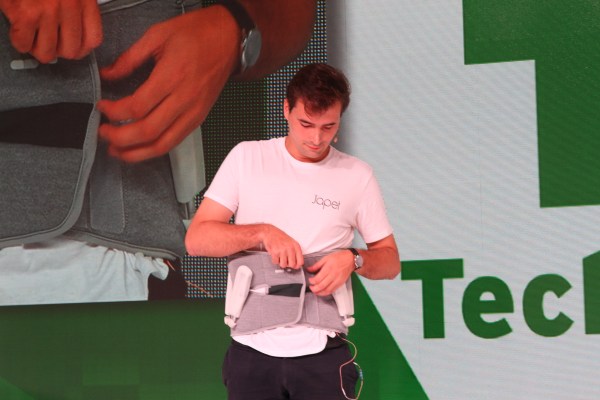At this year’s CES Hardware Battlefield, Japet announced Atlas, a device designed to tackle back pain, which is the No. 1 cause of employee sick leave.
Antoine Noel and Damien Bratic met at engineering school. The pair worked together developing robotic hands for children with disabilities, before parting ways to start on other projects in health technology. Bratic started work on a neurostimulation device for back pain and Noel entered the robotic exoskeleton field. The two eventually reunited in France as the CTO and CEO of Japet Medical Devices.
“We realized that exoskeletons could be a solution for the major health problem that is back pain,” explains Noel. “We did a mockup of a device that would apply force on the torso to decompress the spine and relieve the patient. Now we have three doctors on the team and we slowly began to realize the real use of the device would be to relieve the patient and allow him to slowly retrain his body.”
[gallery ids="1434805,1434812,1434811,1432935,1432933,1432936,1432934,1434803"]
The Atlas device is designed for use twice daily for those suffering from extreme back pain. Each 30- to 45-minute session is built around exercises guided by an application on a connected OEMed Android tablet provided by Japet.
The brace is designed to relieve pain while helping to rehabilitate the patient, using four micro-motors to apply pressure to the spine, while analyzing movement with a series of on-board sensors. The information that’s gathered is transferred to the tablet via Bluetooth, wherein the data is analyzed and progress is tracked over time.
The product will be fairly cost prohibitive at launch – running around $4,500, a price that will likely confine early usage to rehabilitation centers, wherein the patient can utilize the brace under the supervision of a doctor. Noel suggests that there’s a possible secondary market for home users, though finding any sort of success on that front will require a fairly significant price drop.
Among potential options for expanding to that market is the creation of a device that utilizes the product’s pain relieving, but not rehab properties. The Atlas could also potentially be rolled out as a rental for home users, until they get back on their feet. “ Our goal is to restart physical capacity and end the vicious cycle of pain,” says Noel. “And once they are out of it, they won’t need the device anymore.”
The team recently completed early work on the device and is set to begin testing in June, using 10 patients at a local hospital. The plan is to reach their native European market by year’s end and hit the U.S. in another two years, a delayed debut due in part to American regulatory bodies like the FDA.
